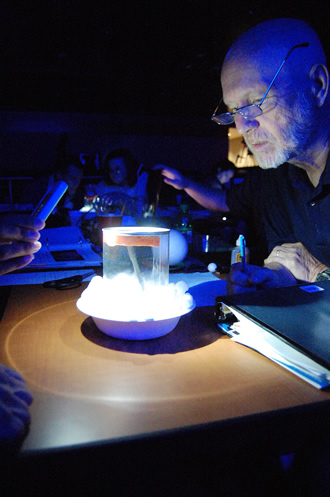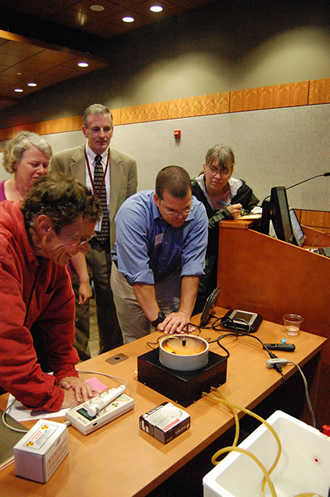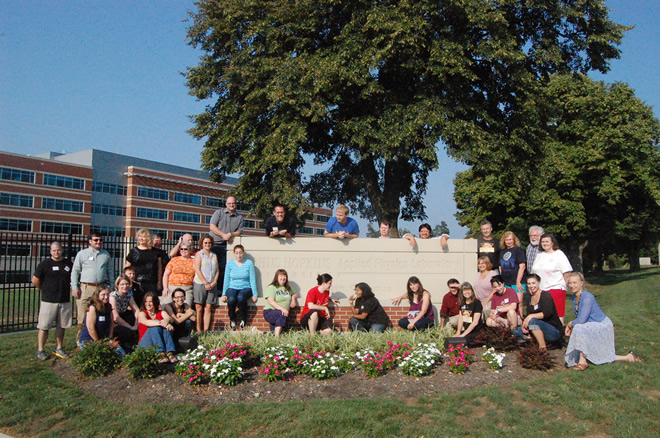August 29, 2012
In the Loop: RBSP Educator Workshop Draws 31 Teachers from 21 States to APL
 
Left: Ray Yoh, middle school science teacher from Newport News, Va., tries to detect cosmic rays in a cloud chamber he built with the help of ECT instrument team members Harlan Spence and Sonja Smith.
Right: RBSP Project Manager Rick Fitzgerald of APL (standing, in tie) joins workshop educators Lynn Powers, Lee Hand, Al Stahler, and Elizabeth Martineau to watch cosmic rays travelling through a cloud chamber. Credit: JHU/APL
In order to spread awareness of the Radiation Belt Storm Probes and how they will help us understand space weather’s effect on the earth, the Applied Physics Laboratory (APL) hosted an Educator Workshop July 31 through Aug. 2.
“I wanted the educators to learn, get excited and pass that knowledge and excitement on to their audiences,” says Dawn Turney, Education and Public Outreach Specialist for the Civil Space Department at APL who organized and ran the event with the help of her colleagues Linda Butler and Alexandra Matiella Novak. “We may have only had 31 people in that room, but think about how many people they will now share RBSP with.”
The group of 31 educators came from 21 states across the country and included middle and high school teachers, college instructors and informal educators from institutions like the Maryland Science Center, NASA Educator Resource Centers (ERCs) and the Bradbury Science Museum in N.M.
The first day of the workshop provided the educators with a general overview of the mission. Deputy Project Scientist Nicola Fox explained what scientific questions RBSP hopes to answer and Mission Systems Engineer Jim Stratton explained how the RBSP spacecraft were built to survive the radiation belts. The group also tested possible classroom activities and toured the main campus of APL.
On the second day, the educators heard presentations from Project Manager Rick Fitzgerald, NASA Launch Services Program Mission Manager Rex Engelhardt and representatives from each of the RBSP instrument suites: Harlan Spence, Principal Investigator for the Energetic Particle, Composition, and Thermal Plasma Suite (ECT); Joseph Mazur from the Relativistic Proton Spectrometer (RPS); Rick Schnurr from the Electric and Magnetic Field Instrument Suite and Integrated Science (EMFISIS); Tom Armstrong, Doug Patterson, and Heather Mull from the Radiation Belt Storm Probes Ion Composition Experiment (RBSPICE); and Steve Brehmer from Electric Field and Waves Suite (EFW). Educators Educationd in a number of activities including building their own cloud chambers to detect cosmic rays.
Turney says she was surprised but pleased to see that speakers like Fox, Stratton and Fitzgerald hung around after their presentations despite their busy schedules to answer questions and observe activities. “I’m impressed by how committed this team is to education,” Turney says.
“It was really wonderful,” says Pam Casto, an education specialist for NASA ERC in West Virginia. “They had really good speakers who got just the right about of context and technical detail for us to understand.”
The third and final day of the workshop allowed educators to brainstorm with each other about how to incorporate the workshop’s information into their classrooms. They also received feedback on their ideas from Keri Hallau, curriculum designer at Montana State University.
“I wanted to come because it sounded like it would go well with the things I teach and because I have a high level of interest in the space program,” says Ray Yoh, a middle school science teacher in Newport News, Va. “I want to integrate space weather more effectively and help the kids understand how auroras are developed. This seemed to be a great opportunity to explore what goes on in the Van Allen belts.”
“I gathered so much stuff there that I took back to my whole department,” says Kristen Oshinsky, a high school teacher in Raleigh, N.C. “One of the things I did over the course of the workshop was make notes that these things were for my biology teachers, these things were for my physics teachers, and these were for my earth science teachers. There’s too much for me to take back to just my classroom so I’m taking it back to everybody.”
“It’s such an important mission,” says Turney. “I don’t think many people know just how important this mission is. The Van Allen region touches so many aspects of our daily life. That’s why I hope these educators share as much as of this information as they can.”
Beyond the workshop, four educators volunteered their time at RBSP’s education booth at the Kennedy Space Center during launch week to share highlights of their workshop experience with the public.

The RBSP Educator Workshop team outside Building 200, home to the APL Space Department. Credit: JHU/APL
RBSP is part of NASA's Living With a Star Program to explore aspects of the connected sun-Earth system that directly affect life and society. LWS is managed by the agency's Goddard Space Flight Center in Greenbelt, Md. APL built the RBSP spacecraft and will manage the mission for NASA.
|




